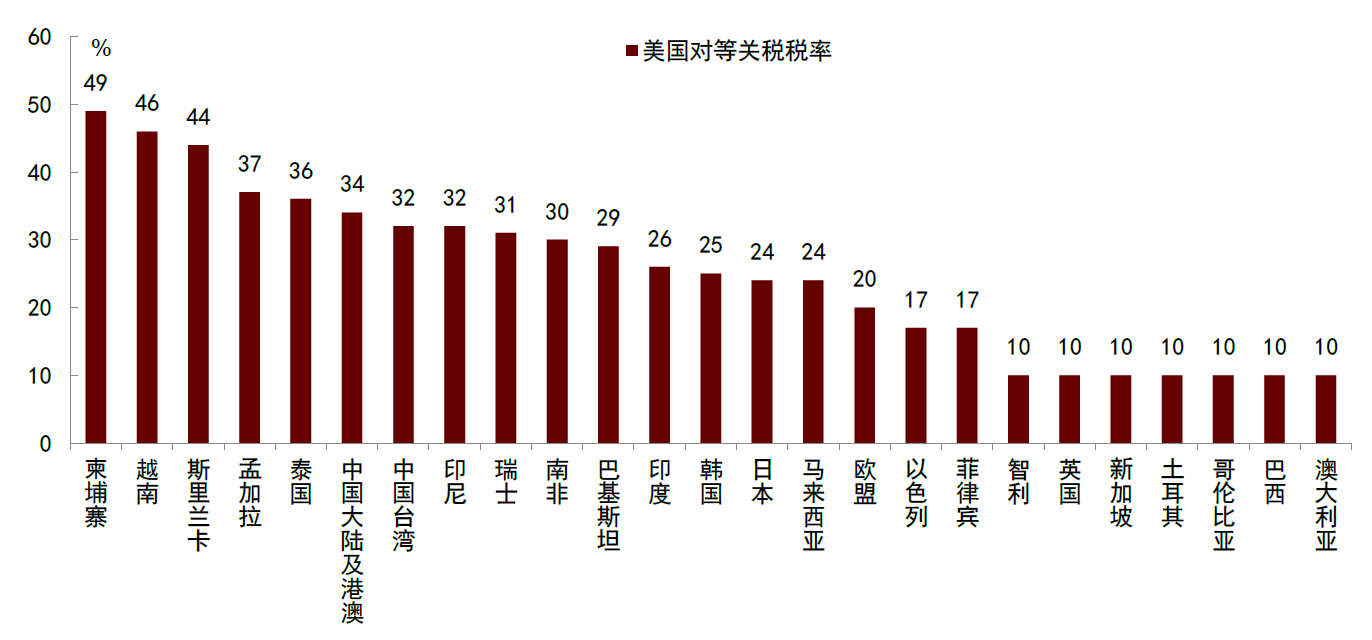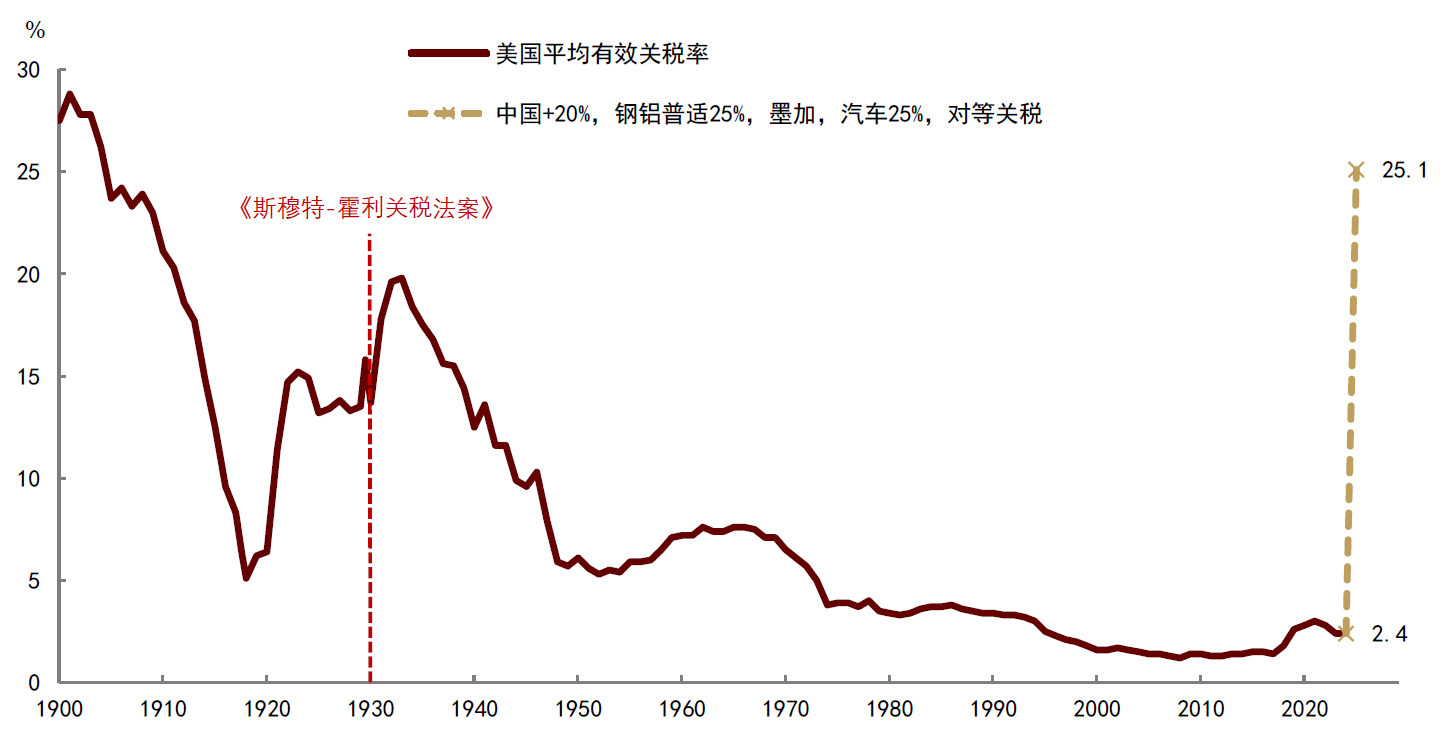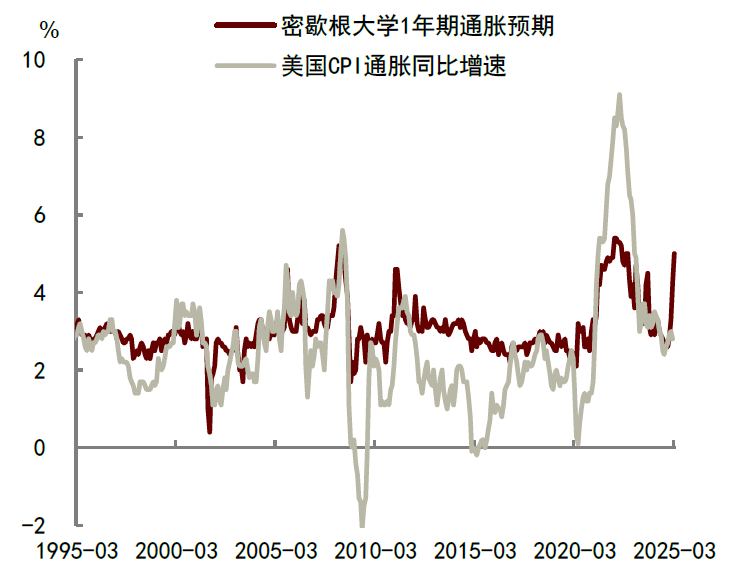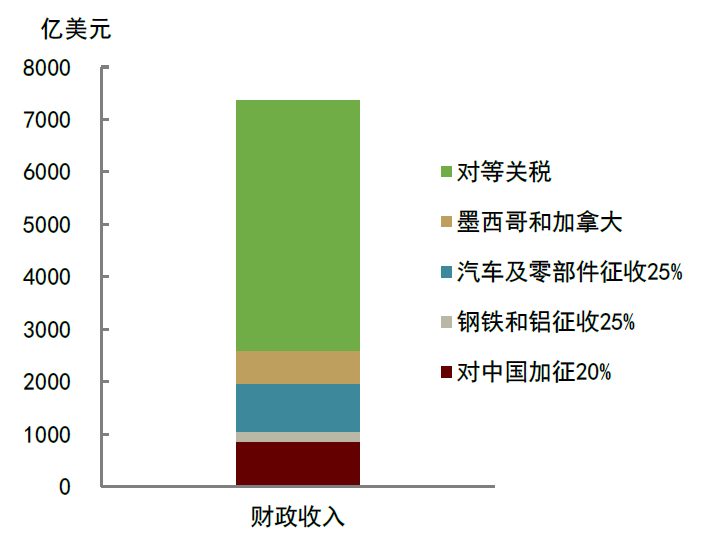Reciprocal tariffs may increase uncertainty and market concerns, exacerbating the risk of "stagflation" in the U.S. economy.
Authors: Xiao Jiewen, Lin Yuxin, CICC Research
On April 2, Trump announced "reciprocal tariffs," with a scope exceeding market expectations. The reciprocal tariffs combine a "carpet" tariff with a "case-by-case" country-specific tariff, covering over 60 major economies. Our calculations show that if these tariffs are fully implemented, the effective tariff rate in the U.S. could rise significantly from 2.4% in 2024 by 22.7 percentage points to 25.1%, surpassing the tariff levels after the implementation of the Smoot-Hawley Tariff Act in 1930. We believe that reciprocal tariffs may increase uncertainty and market concerns, further exacerbating the risk of "stagflation" in the U.S. economy. Our estimates indicate that tariffs could push U.S. PCE inflation up by 1.9 percentage points and reduce real GDP growth by 1.3 percentage points, although they may also generate over $700 billion in fiscal revenue. In the face of stagflation risks, the Federal Reserve can only choose to wait and see, making it difficult to lower interest rates in the short term. This will further increase the risk of economic downturn and add downward pressure on the market.
I. Specifics of Reciprocal Tariffs
At 4 PM U.S. time on April 2, Trump announced the policies related to reciprocal tariffs and signed a presidential executive order[1]. The framework of reciprocal tariffs employs comprehensive "carpet" tariffs combined with country-specific tariffs on a "case-by-case" basis, as stated by the White House:
► The U.S. will impose a basic 10% comprehensive tariff on all imported goods.
This is consistent with the 10% carpet tariff promised during his previous presidential campaign. Industries that have already implemented a 25% tariff rate, such as steel, aluminum, and automobiles, are not affected by this order. Additionally, copper, pharmaceuticals, semiconductors, timber, certain key metals, and energy products are excluded from the reciprocal tariff framework; these industries were mentioned by Trump as candidates for higher tariffs, but specific implementation timelines and rates have not yet been announced[2].
► Some countries and regions will face higher rates.
Currently, the presidential executive order has not published specific appendix details on tariff rates on the White House website, but based on Trump's statements, economies with higher reciprocal tariff rates include the European Union (20%), Japan (24%), South Korea (25%), China (34%), Taiwan (32%), India (26%), and Thailand (36%)[3]. Furthermore, another Fact Sheet released by the White House states that Trump has signed an executive order to end the tariff exemption policy for small packages under $800 starting May 2, imposing a 30% tariff or a $25 tariff per item (which will increase to $50 per item after June 1) on them[4].
Overall, the range of countries and regions facing higher tariffs aligns with what U.S. Treasury Secretary Yellen previously stated, that the Trump administration is focusing reciprocal tariffs on economies where trade imbalances with the U.S. persist[5]. This is also consistent with our previous judgment in the report "Outlook on Trump's 'Reciprocal Tariffs'," indicating that countries and regions with higher surpluses and tariff rates are more likely to be targeted by reciprocal tariffs. However, the actual implemented rates may even exceed our previous extreme scenario assumptions.
► Mexico and Canada continue to enjoy exemptions under the previous USMCA framework and are not impacted by additional reciprocal tariffs.
The presidential executive order states that tariffs previously imposed on illegal immigration and fentanyl will remain in effect, but exemptions are extended, meaning that all goods from Canada or Mexico that meet USMCA agreement conditions will continue to enjoy preferential access to the U.S. market. However, goods from Canada or Mexico that do not meet USMCA requirements will now face an additional 25% ad valorem tariff (10% for Canadian energy).
► In terms of implementation timeline, according to the presidential executive order, all goods entering U.S. customs territory will incur an additional 10% ad valorem tariff starting April 5, 2025, while goods from trade partners facing higher reciprocal tariffs will see new tariff rates implemented starting April 9.
Our calculations show that if the aforementioned tariffs are fully implemented, the effective tariff rate in the U.S. will rise significantly from 2.4% in 2024 by 22.7 percentage points to 25.1%. This level exceeds our extreme scenario in the outlook report "Outlook on Trump's 'Reciprocal Tariffs'" and will surpass the tariff levels in the U.S. after the implementation of the Smoot-Hawley Tariff Act in 1930 (Chart 2).
II. Reciprocal Tariffs Increase Uncertainty
We believe that reciprocal tariffs not only fail to alleviate uncertainty but will further exacerbate concerns.
First, the broad scope and significant magnitude of reciprocal tariffs will have a major impact on both the U.S. and global economies. How will countries respond after the implementation of tariffs? Will they choose to retaliate or endure? If retaliatory measures are taken, it could lead to an escalation of the tariff war, putting more downward pressure on the global economy, a risk that warrants attention.
Second, will there be more tariffs after reciprocal tariffs? Trump previously indicated plans to impose tariffs on semiconductors, medical products, timber, copper, etc. When will these measures be implemented? Additionally, reciprocal tariffs do not currently include Mexico and Canada, which are exempt from tariffs on goods that meet the USMCA agreement. There is uncertainty regarding how future policies will change.
Third, how long will reciprocal tariffs last? Is there a possibility to reduce them through negotiations in the future? If negotiations occur, when can they start? In the long term, Trump hopes to promote the return of manufacturing through increased tariffs and intends to use tariff revenues to offset the fiscal deficit caused by tax cuts. If Trump insists on achieving these goals, does that mean tariffs will not be temporary but will have a certain degree of permanence? These questions remain unanswered.
III. Impact on the U.S. Economy
If the aforementioned tariffs persist, the U.S. economy will face a more severe risk of "stagflation." First, economic growth decline will be difficult to avoid. From a micro perspective, after the imposition of tariffs, businesses face two choices: to raise prices or not to raise prices. If they choose to raise prices, consumers will bear higher costs, demand will slow down, and economic downward pressure will increase. If they choose not to raise prices, their own profits will be squeezed, and the demand for employment will weaken, ultimately leading to economic slowdown.
From a macro perspective, tariffs essentially represent an increase in government revenue, with businesses and consumers bearing the costs, and their effect is equivalent to fiscal tightening. Trump's imposition of tariffs will lead to a transfer of money from the private sector back to the government sector, reducing net assets in the private sector, which will suppress investment and consumer spending. Among private sector entities, who bears the cost of tariffs will depend on the bargaining power between producers in other countries and regions and U.S. consumers, as well as changes in the exchange rates of these countries and regions relative to the U.S. dollar. Of course, these tariff revenues may eventually be returned to U.S. businesses and consumers in the form of tax cuts, but at least in the short term, they will have a negative impact on overall demand.
Second, tariffs will push up price levels, increasing upward pressure on inflation in the short term. Although weak demand will ultimately suppress inflation, consumers may first experience a wave of price increases. According to a survey by the University of Michigan, U.S. consumers' inflation expectations for the next year surged to 5% in March, the highest since 2022, while expectations for inflation over the next 5-10 years rose to 4.1%, the highest since 1993 (Chart 3). The implementation of reciprocal tariffs will exacerbate short-term price increase pressures, thereby increasing the risk of self-fulfilling inflation expectations.
Our calculations show that based on previous tariffs, adding reciprocal tariffs could push U.S. PCE inflation up by 1.9 percentage points, increase U.S. fiscal revenue by $737.4 billion, and reduce U.S. real GDP growth by 1.3 percentage points (Chart 4). Our estimates above do not consider exchange rate changes. If the dollar appreciates, the impact on the U.S. will weaken. Conversely, negative impacts will intensify. Additionally, we assume that U.S. consumers and overseas producers share the tariff burden equally, meaning half of the cost increase is passed on to U.S. consumers, while the other half is borne by trade partners, and we assume the tax multiplier in the U.S. within a year[6] is about 1. If U.S. consumers have weak bargaining power, the negative impact on the economy will be even greater.
IV. Implications for Monetary Policy
In the face of "stagflation" risks, the Federal Reserve can only choose to wait and see, making it difficult to lower interest rates in the short term. Based on our calculations above, reciprocal tariffs may bring significant inflation risks, coupled with the current rise in consumer inflation expectations, which will force the Federal Reserve to refocus its policy on "inflation prevention." We believe that after the implementation of reciprocal tariffs, the Federal Reserve will need at least two months to assess their actual impact on inflation. Therefore, unless the U.S. economic situation is extremely weak, it will be difficult for the Federal Reserve to make a decision to lower interest rates in the first half of the year. The difficulty in lowering interest rates means the absence of a "Federal Reserve put option," which will further increase the risk of economic downturn in the U.S. and add downward pressure on the market.

Chart 1: U.S. Reciprocal Tariff Rates
Source: White House, NBC News, CICC Research

Chart 2: U.S. Effective Tariff Rate Will Rise Significantly
Note: 1900-1918 and 2024 are U.S. government fiscal years, 1919-2023 are calendar years, and 2025 is an estimate by the authors.
Source: USITC, Wind, CICC Research

Chart 3: U.S. Consumer Inflation Expectations Surge
Source: Haver, CICC Research

Chart 4: U.S. Fiscal Revenue Expected to Increase Due to Tariffs
Source: USITC, Wind, CICC Research
免责声明:本文章仅代表作者个人观点,不代表本平台的立场和观点。本文章仅供信息分享,不构成对任何人的任何投资建议。用户与作者之间的任何争议,与本平台无关。如网页中刊载的文章或图片涉及侵权,请提供相关的权利证明和身份证明发送邮件到support@aicoin.com,本平台相关工作人员将会进行核查。




